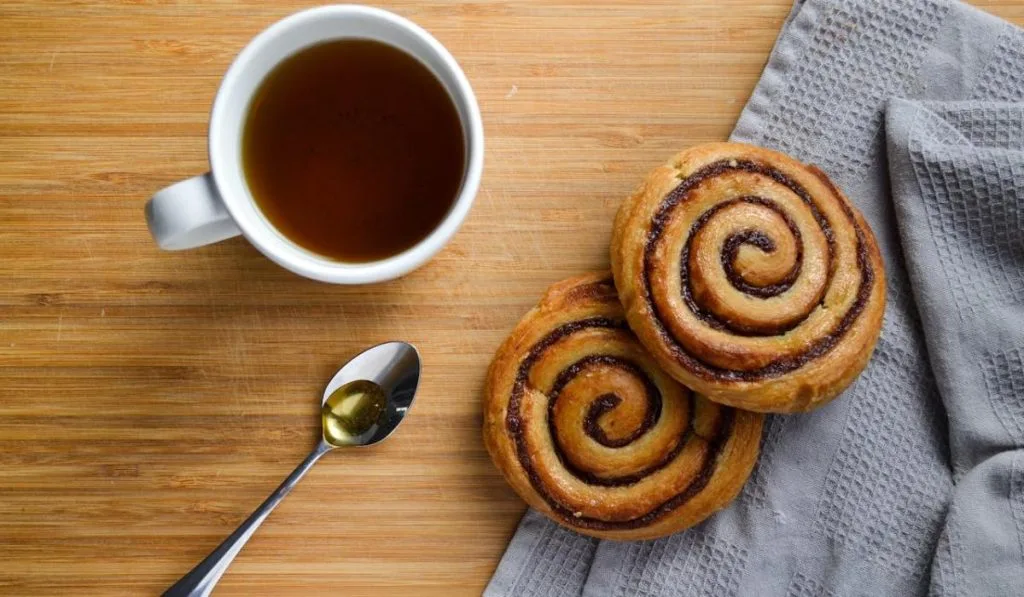Ever felt a little guilty tossing that sourdough discard? You’re not alone.
You’re lovingly feeding your starter day in and day out, and then… bam! Half of it ends up in the trash. Wasteful, right? That pang of guilt hits—what if there was a delicious way to put that discard to good use?

Fluffy, tangy, sweet swirls of joy that transform “waste” into a weekend-worthy treat. No more sad goodbyes to starter discard. These cinnamon rolls might just become your new breakfast obsession—and your most-requested bake at brunch.
TL;DR – Why You’ll Love These Cinnamon Rolls
- ✨ Use up sourdough discard in the tastiest way possible—no waste!
- 💡 Balanced sweet-tangy flavor adds depth to traditional cinnamon rolls
- ⏰ Flexible schedule: can be prepped overnight or same-day
- 😋 Buttery-soft texture that rivals any bakery version
- 🔥 Secret ingredients and tips from the sourdough trenches
The Cinnamon Roll Revival: Why Discard Deserves a Second Chance
Once dismissed as nothing more than a byproduct, sourdough discard has been quietly stepping into the spotlight—and for good reason. In recent years, more and more bakers have started to realize that this humble mixture of flour and water is far from garbage. Instead, it’s the secret ingredient that can take your baked goods from ordinary to extraordinary.
And when it comes to cinnamon rolls? Discard isn’t just a stand-in for yeast or a clever hack. It’s a full-blown upgrade.
Why Sourdough Discard Changes the Cinnamon Roll Game
Sourdough discard brings a beautiful tang to your dough that perfectly balances the rich, sweet cinnamon-sugar filling. That touch of acidity isn’t overpowering—it’s subtle but powerful enough to cut through the sweetness and leave you reaching for “just one more bite.”
Plus, the fermentation from your discard doesn’t just add flavor. It transforms the texture, giving your cinnamon rolls a pillowy softness with just the right amount of chew.
Complex Flavors You Didn’t Know You Needed
The magic of sourdough is in its fermentation. When you bake with discard, you’re introducing natural, caramel-like undertones that aren’t present in traditional yeast doughs. It’s like adding a layer of depth to every single swirl of your roll—something you can taste but can’t quite put your finger on.
This is what makes sourdough discard cinnamon rolls taste like they’ve been crafted by a pastry chef in a high-end bakery.
Baking with Discard: A Deliciously Eco-Friendly Choice
Let’s talk about the best bonus of all: no more waste. If you’ve been tossing your unfed starter during regular feedings, here’s your chance to turn that “waste” into something wonderful. Using discard isn’t just good for your taste buds; it’s good for your conscience too.
You’ll feel like an eco-conscious baking hero knowing you’ve saved your starter from the trash and turned it into a tray of golden, gooey cinnamon rolls.
How to Make Sourdough Discard Cinnamon Rolls
This isn’t your quick yeast roll recipe, and that’s a good thing. Sourdough discard cinnamon rolls are a slower, gentler process, giving you time to develop flavor, texture, and anticipation.
What You’ll Need
Dough Ingredients:
- 1/2 cup sourdough discard (unfed, from the fridge is fine)
- 1/2 cup warm milk
- 2 1/4 tsp active dry yeast
- 3 cups all-purpose flour
- 1/4 cup granulated sugar
- 1/2 tsp salt
- 1/3 cup softened butter
- 1 large egg
Filling Ingredients:
- 1/2 cup brown sugar
- 1 1/2 tbsp cinnamon
- 1/4 cup softened butter
Cream Cheese Frosting:
- 4 oz cream cheese
- 2 tbsp softened butter
- 3/4 cup powdered sugar
- 1/2 tsp vanilla extract
- Pinch of salt
Step-by-Step Directions
- Activate the yeast: In a bowl, mix warm milk and yeast. Let it bloom for 5–10 minutes until foamy.
- Make the dough: Add sourdough discard, sugar, egg, and butter to the yeast mix. Slowly incorporate flour and salt. Knead 8–10 minutes until smooth.
- First rise: Let the dough rest, covered, for 1–2 hours until doubled.
- Shape the rolls: Roll dough into a rectangle, spread with butter, sprinkle cinnamon-sugar mixture, and roll up tightly. Slice into 9 rolls.
- Second rise: Let rolls rise in a greased pan for 45–60 minutes (or overnight in the fridge).
- Bake: 350°F for 22–25 minutes until golden and puffy.
- Frost: Blend frosting ingredients and slather on warm rolls.

Secret Tips
These aren’t your average cinnamon rolls. Over the years, I’ve discovered a few game-changing techniques that take them from simple homemade treats to full-on bakery showstoppers. With the right tricks, you can create rolls that are fluffy, gooey, and loaded with that irresistible sweet-tangy flavor that keeps people coming back for more.
1. Use Cold Discard
Cold discard gives the dough more body and helps with that light, chewy texture. You don’t need to bring it to room temp.
2. Add a Splash of Buttermilk
If you like extra tang and a soft crumb, replace half the milk with buttermilk. It plays beautifully with the sourdough notes.
3. Overnight Rise = Flavor Bomb
Letting the shaped rolls rise overnight in the fridge enhances the dough’s depth and makes for an easy morning bake.
American Comfort Food with a Sourdough Twist
There’s something undeniably nostalgic about cinnamon rolls. They belong in church bake sales, family brunches, lazy Sunday mornings, and potluck tables across the U.S.
But these sourdough discard cinnamon rolls feel fresher. Lighter. More modern.
They’re:
- Perfect for Midwest winters with hot cocoa
- Just right for California foodies chasing fermented trends
- Ideal for busy moms in Texas looking for make-ahead breakfasts
- A fun twist for NYC bakers trying to stand out in a brunch crowd
Why This Recipe Works (Even for Beginners)
Let’s break it down—real talk style:
- You don’t need to be a pro baker. The dough is forgiving.
- Discard adds depth without fuss. You’re not making a full-on sourdough bread here.
- It’s customizable. Swap out the filling for apple pie spice or cardamom.
And if you’re wondering about the nutrition side—you’re baking a treat, not a kale salad. But the fact that you’re using fermented starter means there are digestive perks like lactic acid, which may help reduce gluten content and make the rolls a little gentler on your gut.
Conclusion: Sweet Redemption in Every Bite
Who knew that the gunky leftovers from your sourdough starter could be reborn as something so sweet, so sticky, so irresistibly good?
Sourdough discard cinnamon rolls are more than just a baking hack—they’re a celebration of transformation. From waste to wonder, they represent everything we love about sourdough: patience, depth, and a little wildness.
So next time you’re scraping out your starter jar, remember—you’re not throwing away potential. You’re just a few steps away from cinnamon roll nirvana.
FAQs
Can I make these without yeast?
Technically yes, but they won’t rise the same way. The discard alone doesn’t provide enough leavening for fluffy rolls.
What’s the difference between discard and active starter?
Discard is unfed and slightly more acidic. It adds flavor, not leavening. Active starter is bubbly and strong enough to rise bread on its own.
Can I freeze the dough or the baked rolls?
Absolutely! Freeze after shaping or after baking. Just reheat gently and frost when warm.
What kind of discard works best?
100% hydration (equal parts flour and water) works best. Whole wheat or rye discard adds even more flavor.
Can I prep them the night before?
Yes! Shape the rolls, place in the pan, cover, and refrigerate overnight. Bake the next morning.
Why are my rolls dense?
Likely under-proofed or over-floured. The dough should feel soft, tacky but not sticky.
Is it okay to use cold discard straight from the fridge?
Definitely! It blends right into the dough and helps keep everything cool and easy to work with.
Can I make these vegan?
Yes! Use plant-based butter and milk. For the egg, sub 1/4 cup applesauce or a flax egg.
What’s the ideal flour to use?
All-purpose flour works great. For extra richness, mix with a bit of bread flour.
Do I need to adjust for altitude or humidity?
If you’re baking in high altitude or high humidity, reduce liquid by 1–2 tablespoons and keep an eye on proofing times.
Join Us and Transform >
Don’t Be an Amateur! Master the Art of Sourdough Bread!




Leave a comment